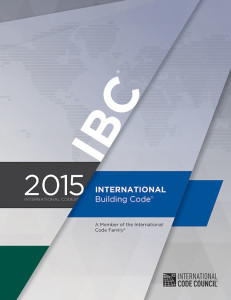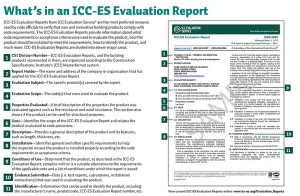Evaluation of Innovative Building Products
By definition, innovative means “tending to innovate or introduce something new or different”. Within the context of the International Building Code (IBC), Section 104.11 Alternative materials, design and methods of construction and equipment provides a mechanism for how building officials can approve innovative, new or alternative building materials, design and methods of construction that are not adequately addressed in the code. Alternatives to what are listed in the IBC are acceptable as long as the quality, strength, effectiveness, fire resistance, durability and safety are proven equivalent. This code provision has stood the test of time and provided a pathway to building code approval for countless new and innovative building materials through the conformity assessment process.
Conformity assessment applies across the spectrum of products and systems used in daily life including electronics, medical devices, appliances, automobiles that we drive, and even building material products used in construction of our homes and businesses. The framework for evaluating building material products for compliance with codes and standards is ultimately regulated by the International Organization for Standardization (ISO) through the development and publication of ISO/IEC 17065. Conformity assessment is a means to protect the public and boosts consumer confidence that products have met accepted industry standards. It also helps building officials ensure life safety and environmental requirements of the code are met. For building material manufacturers, it provides a means for significant differentiation from competitors with independent proof of a better, more effective product.
Three key elements of conformity assessment include testing, certification and inspection. Building material products are commonly tested through accredited testing laboratories, such as those accredited by the International Accreditation Service (IAS), in order to establish compliance and confirm performance characteristics as required in ASTM test standards and Acceptance Criteria. Certification is carried out by an independent party that issues a certificate stating the product meets required codes and standards. This is third party conformity assessment. Inspection involves the process of checking the product quality system periodically to ensure it continues to meet required standards. All three aspects of conformity assessment are necessary in order to ensure the safety, reliability and effectiveness of building material products used in today’s complex structures.
ISO maintains many different standards. Three are of particular importance to construction and the building material product industry. Testing laboratories are governed by ISO 17025 General Requirements for the Competence of Testing and Calibration Laboratories. Certification bodies are governed by ISO 17065 Conformity assessment – Requirements for bodies certifying products, processes and services. Inspection is governed by ISO 17020 Conformity assessment – Requirements for the operation of various types of bodies performing inspection. These three ISO standards include separate requirements for the specific entities involved, and underpin the entire building material evaluation process.
So Why is This Important to Practicing Structural Engineers?
One of the reputable bodies for evaluating and certifying building material products, ICC Evaluation Service (ICC-ES) is a non-profit subsidiary of the International Code Council (ICC), the organization that writes the IBC, International Residential Code (IRC) and many other model codes. ICC-ES has been engaged in the process of evaluating innovative building products for compliance with the codes for decades. ICC-ES is the only conformity assessment body accredited by the American National Standards Institute (ANSI) to ISO 17065 as having the capability of conducting product evaluation to ICC-ES acceptance criteria, and fully complies with IBC Section 1703 Approvals. These provisions contain requirements for approved agencies, building material product performance, labeling and follow-up inspection services. Approval is based on information provided to the Building Official by the approved agency. The Building Official must first determine if the agency meets the applicable requirements of IBC Section 1703. ANSI accreditation is not the sole determining factor for compliance with Section 1703 however. Approved agencies must be independent, well-equipped and thoroughly staffed with experienced personnel. To be approved by a Building Official, such agencies must demonstrate their objectivity by disclosing any potential conflicts of interest. They must also have educated and trained personnel experienced in conducting and supervising product evaluations. Due to the relationship with the ICC parent organization, ICC-ES is the most well recognized and approved evaluation agency. Evaluation reports developed by ICC-ES technical staff are widely accepted and trusted technical reports across jurisdictions throughout the U.S.
How Are ICC-ES Evaluation Reports Developed?
The ICC-ES process entails development of Acceptance Criteria through a transparent process that is open to the public. Comprised of Building Officials from throughout the U.S., the ES Committee convenes three times annually to review and approve Acceptance Criteria proposals. These can be for new Acceptance Criteria or revisions to existing Acceptance Criteria. Acceptance Criteria are internal documents intended for use solely by ICC-ES within the ICC-ES scope of accreditation. Over many years, ICC-ES has developed and currently maintains hundreds of Acceptance Criteria for innovative, alternative products and systems. A few examples of ICC-ES Acceptance Criteria for innovative products include AC13 Acceptance Criteria for Joist Hangers and Similar Devices, AC14 Acceptance Criteria for Prefabricated Wood I-Joists, AC43 Acceptance Criteria for Steel Deck Roof and Floor Systems, AC156 Acceptance Criteria for Seismic Certification by Shake-Table Testing of Nonstructural Components and AC308 Acceptance Criteria for Post-Installed Adhesive Anchors in Concrete Elements. This is just a small sample of many ICC-ES Acceptance Criteria, each representing a tremendous engineering and research effort.
In developing Acceptance Criteria, ICC-ES seeks input from interested parties including product manufacturers, researchers, standards developing organizations, structural engineers and other design professionals. Various structural engineering associations have also historically been involved in the ICC-ES Acceptance Criteria development process and have volunteered their valuable time and expertise to provide technical input. This collaboration with structural engineering associations and other subject matter experts strengthens the ICC-ES process.
Acceptance Criteria can also be vetted through an Alternative Criteria Process via website postings for cases where the subject of the proposed criteria is nonstructural, does not involve life safety, and is addressed in nationally recognized or generally accepted industry standards. Where a new Acceptance Criteria is needed but other criteria and/or the code provide precedent for its content, or where relatively minor revisions are being proposed to an existing Acceptance Criteria, are also considerations. The ICC-ES Alternative Criteria Process can provide a quick turn-around for approval or a springboard for review and approval at an ES Committee hearing.
Once the Acceptance Criteria has been reviewed and approved by the ES Committee, the roadmap is set for ICC-ES to issue Evaluation Service Reports (ESRs). The ESR provides the building officials with evidence under the IBC Section 104.11.1 Research Reports requirement. Building product manufacturers submit applications with performance test data in the form of qualified test reports conforming to ICC-ES AC85 Acceptance Criteria for Test Reports. Test reports are based on testing done by an IAS or a signatory to the Mutual Recognition Arrangement (MRA) of the International Laboratory Accreditation Cooperation (ILAC) testing laboratories. Accreditation for the specific type of testing required by the applicable test standards and Acceptance Criteria is essential. Other materials submitted by the building product manufacturer include product information, installation instructions, engineering calculations and manufacturing quality control documentation. Separate, but parallel evaluations are done for both the technical and manufacturing quality aspects of the submittal. Once all issues are resolved on the technical and manufacturing quality reviews, an ESR is issued and published on the ICC-ES website directory. The manufacturer is then able to apply the ICC-ES mark of conformity and ESR number to the evaluated product labels as proof of conformity, and market the recognition for use under specific versions of the IBC or IRC.
Periodic follow-up inspections of the manufacturing locations are then conducted by ICC-ES for the life of the ESR to ensure the evaluated building product continues to conform to the requirements of applicable protocols. This is a critical component of the evaluation process that is not seen by structural engineers and building officials, but goes on behind the scenes between ICC-ES and the report holder.
How Can This Improve the Quality of My Structural Engineering Practice?
The ICC Evaluation Service mark of conformity and ESR number on building product packaging provides confidence and peace-of-mind to structural engineers and building officials alike. The authorized ICC-ES mark shows that the building product has been subjected to a rigorous technical and manufacturing quality review. The ESR contains technical details including scope of evaluation, product use, design and installation, conditions of use, evidence submitted and product identification (see Report).
ICC-ES ESRs are developed to ensure that materials, designs and products are tested to safeguard public safety while allowing innovation to thrive. The ESR allows the structural engineer and building official to readily approve building products rather than having to spend valuable time and resources to research whether or not the building product meets numerous code and standards requirements. Supplemental evaluations to the California Building Code (CBC) and Florida Building Code (FBC) are also possible, and may include separate seismic or high wind evaluations for these unique and demanding applications. Independent evaluation reports are a key feature of the building product market, and structural engineers and building officials look for them. Holding a building product evaluation report streamlines the approval process, saving time and money before and during construction.
How Can I Get Involved and What’s In It For Me?
First, go ahead and visit www.icc-es.org and request to be added to the ICC-ES mailing list. This will keep you abreast of updates on ICC-ES Acceptance Criteria, new ESRs and other code related news. As part of your due diligence, require current ICC-ES ESRs from building product manufacturers in your design practice. This establishes a basis of design and level playing field for product manufacturers requesting your approval and project specification, and will allow you to specify with confidence. Check the ESR Evaluation Scope to make sure it references the right building code version for your design project, and the ESR Evidence Submitted to make sure it references the appropriate version of the Acceptance Criteria. This reduces potential error by improperly designing with a product that hasn’t been thoroughly evaluated to the appropriate version of the code. Verify ESR Conditions of Use for the product to understand any limitations. This avoids designing with a product that hasn’t been tested and evaluated for special conditions, such as seismic loading or fire resistance. Finally, provide feedback to ICC-ES as part of the Acceptance Criteria process, or when questions arise regarding ESRs. Opening a dialogue with ICC-ES will get you involved in the process and let them know what’s important to you and your design practice.▪


